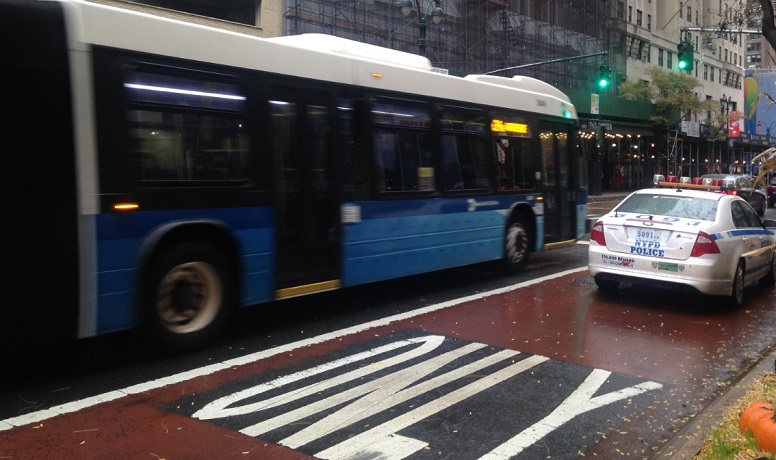You might have thought the biggest transportation story coming out of New York this year was about a pizza-loving rodent, but if you’ve been paying attention, you might have heard about Citi Bike upgrades and expansion, a debate between the governor and the mayor over the MTA, progress on a highway-to-boulevard conversion in Rochester and two upstate towns leading the way on complete streets.
The Good
Bike-ped access receiving more priority from transit agencies and government — Pedestrians and bicyclists account for nearly 30 percent of traffic fatalities in New York. But some New York communities are doing their part to reverse that trend. As of 2014, 53 jurisdictions in New York had adopted complete streets policies. Two upstate towns, Ogdensburg and Troy, received the top two rankings in the nation for their efforts to make streets safer and more accessible for all road users. Meanwhile, the process to replace the sunken Inner Loop in downtown Rochester with a bike-ped friendly boulevard began earlier this year. The new boulevard–funded in part by a $16.7 million TIGER grant–will feature wide sidewalks and dedicated bike lanes, and will open up six acres of land to mixed-use redevelopment. Since the freeway’s completion in the 1950s, Rochester’s population has fallen by more than a third. Also, the MTA made bike-ped progress by announcing it would study adding a bicycle and pedestrian pathway to the Verrazano Narrows Bridge and (finally) installed bike racks on S53 and S93 buses as part of a one-year pilot program.
Transportation options expanding throughout the city — The long-awaited 7 train extension finally reached the far west side of Manhattan this year. Its opening, nearly two years behind schedule, marked the first new subway station in 26 years. The station connects existing residents and intercity bus travelers, as well as visitors to the High Line and Javits Center, to 18 other subway lines. Meanwhile, after its 2013 launch, Citi Bike quickly become the nation’s largest bike share system, but it was plagued by technology problems. In 2015, under new ownership and a new CEO, the system got new software, new redesigned bikes, and new stations in Brooklyn, Queens and on Manhattan’s Upper East and West Sides. Meanwhile, outer borough residents in less transit-dense neighborhoods benefited from the rise of Uber and ride-share services.
The Bad
Fears and inaccuracies about tolling are pervasive despite data — Many of Queens’ elected officials have come out in support of the Move New York Fair Plan, which, if adopted, would result in higher tolls for less than 4 percent of Queens commuters. The handful who haven’t yet supported Move NY, call the proposal “an undue burden on low- and middle-income working families” aimed at keeping “the common folk out of central Manhattan by financially squeezing them out of their cars.” But they haven’t provided evidence that the plan would disproportionately burden a plurality of their constituents — perhaps because that evidence simply doesn’t exist.
State transportation agencies’ cloistered capital planning processes — Albany’s reputation for being run behind closed doors is nowhere more evident than in the opaque and unregulated New York State Department of Transportation capital plan process. Unlike the MTA, NYSDOT has no legal requirement to submit a 5-year capital plan and no requirement to release its capital plan to the public. In fact, this past budget season, legislators approved a 2-year plan that wasn’t available—to the public or legislators—until six months after the vote was taken. Even now, the document can’t be found anywhere on the web. And the Port Authority gave the public only 11 days for to review its 100-page, $7.9 billion capital and operating budget plan before the Board of Directors was to review public comment and vote on the draft.
The Ugly
The fight for statewide transit funding — The push to adopt a fully-funded 5-year MTA capital program subjected New Yorkers to “months of unnecessary bickering” and an awkward public back-and-forth at the opening of the new 34th Street/Hudson Yards Station. Yes, Governor Andrew Cuomo and Mayor Bill de Blasio did finally make a deal, but not without some unfortunate moments. But even after a deal was reached, the fight wasn’t over: Senate Majority Leader John Flanagan was quick to call for parity for upstate roads and bridges. Lost in the discussion was a similiar call for likewise improvements to transit, pedestrian and biking infrastructure.
NYC’s Right of Way debate — There was contentious debate between street safety advocates and the Transport Workers Union regarding the application of New York City’s Right of Way law to MTA bus drivers. TSTC Executive Director Veronica Vanterpool wrote in a NY Daily News op-ed, “The intent of the Right of Way law is not to criminalize the hard-working women and men who operate buses. The law is intended to protect the most vulnerable users of our streets by creating a driving culture of extreme safety and caution.”
NYPD’s misplaced priorities — In a year during which 14 people were killed by curb-jumping drivers, the NYPD painted over a bike lane, did not attend a City Council hearing on Vision Zero, launched crackdowns on walking and biking, and rolled back the department’s internal parking reform rules. To top it off, in response to annoying street performers, NYPD Commissioner Bill Bratton called for the removal of the Times Square’s pedestrian plazas.


Nice Cutting Bus Service to the entire part of east Nassau On North/South Lines is even worse then anything reported in this article